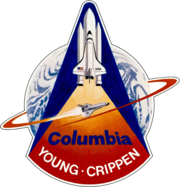STS 1

The launch of STS-1
|
|
| Mission type | Test flight |
|---|---|
| Operator | NASA |
| COSPAR ID | 1981-034A |
| SATCAT no. | 12399 |
| Mission duration | 2 days, 6 hours, 20 minutes, 53 seconds |
| Distance travelled | 1,728,000 kilometres (1,074,000 mi) |
| Orbits completed | 37 |
| Spacecraft properties | |
| Spacecraft | Space Shuttle Columbia |
| Crew | |
| Crew size | 2 |
| Members |
John W. Young Robert L. Crippen |
| Start of mission | |
| Launch date | 12 April 1981, 12:00:03 UTC |
| Launch site | Kennedy LC-39A |
| End of mission | |
| Landing date | 14 April 1981, 18:20:57 UTC |
| Landing site | Edwards, Runway 23 |
| Orbital parameters | |
| Reference system | Geocentric |
| Regime | Low Earth |
| Perigee | 266 kilometres (165 mi) |
| Apogee | 271 kilometres (168 mi) |
| Inclination | 40.3 |
| Period | 89.88 minutes |
| Epoch | 13 April 1981 |
 John W. Young and Robert L. Crippen |
|
STS-1 (Space Transportation System-1) was the first orbital spaceflight of NASA's Space Shuttle program. The first orbiter, Columbia, launched on 12 April 1981 and returned on 14 April, 54.5 hours later, having orbited the Earth 37 times. Columbia carried a crew of two – mission commander John W. Young and pilot Robert L. Crippen. It was the first American manned space flight since the Apollo-Soyuz Test Project in 1975. STS-1 was also the only maiden test flight of a new US spacecraft to carry a crew, though it was preceded by atmospheric testing of the orbiter and ground testing of the space shuttle system.
The launch occurred on the 20th anniversary of the first-ever human spaceflight. This was a coincidence rather than a celebration of the anniversary; a technical problem had prevented STS-1 from launching two days earlier, as was planned.
Both Young and Crippen were selected as the STS-1 crew in March 1978. Young was the most experienced astronaut in NASA at the time and was also the only member of his astronaut class in service. He had first flown in 1965 as pilot of Gemini 3, the first manned flight of the Gemini program, and would later command Gemini 10 in 1966. After the conclusion of the Gemini program, Young flew as command module pilot of Apollo 10 in 1969 and walked on the Moon as commander of Apollo 16 in 1972. He later became Chief of the Astronaut Office in 1974. Crippen, who had joined NASA in 1969 after the cancellation of the Manned Orbiting Laboratory, was a rookie and would become the first of his astronaut group to fly in space. Prior to his selection on STS-1, Crippen participated in the Skylab Medical Experiment Altitude Test and also served as a capsule communicator for all three Skylab missions and the Apollo-Soyuz Test Project.
...
Wikipedia

